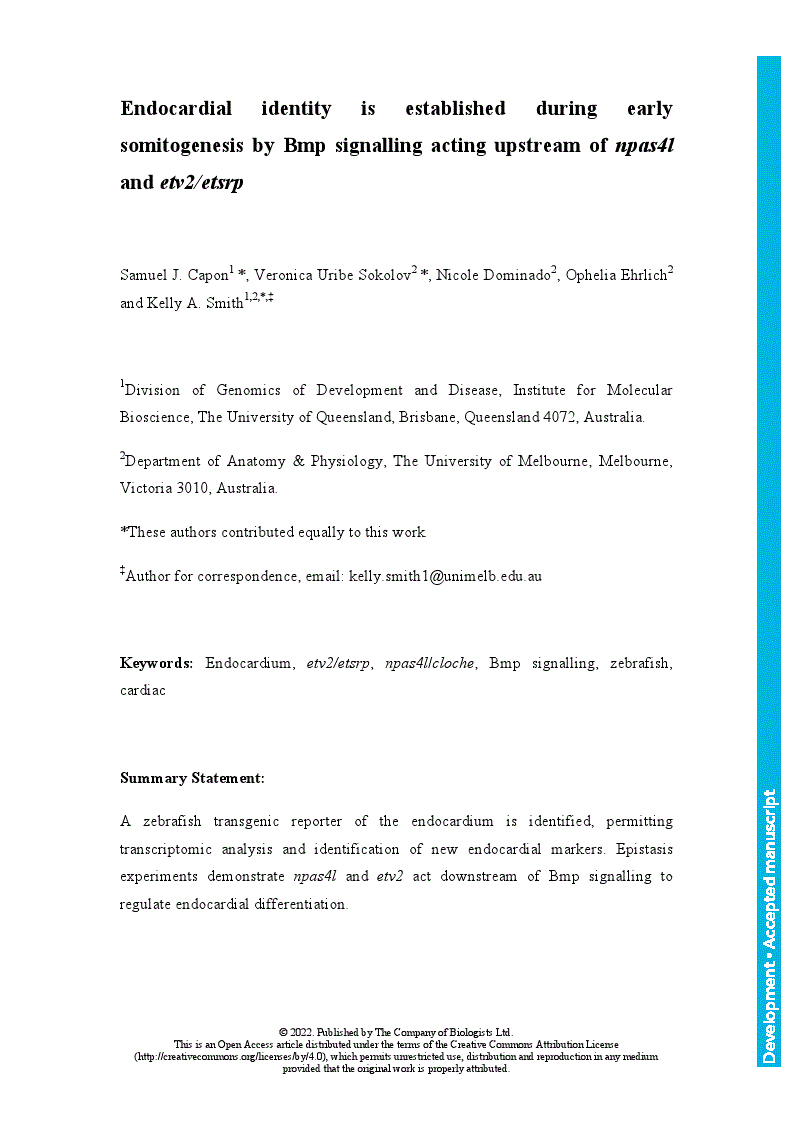The endocardium plays important roles in the development and function of the vertebrate heart however few molecular markers of this tissue have been identified and little is known about what regulates its differentiation. We describe here the Gt(SAGFF27C); Tg(4xUAS:egfp) line as a marker of endocardial development in zebrafish. Transcriptomic comparison between endocardium and pan-endothelium confirms molecular distinction between these populations and time-course analysis suggests differentiation as early as 8 somites. To investigate what regulates endocardial identity, we employed npas4l/cloche, etv2/etsrp and scl loss-of-function models. Endocardial expression is lost in cloche mutants, significantly reduced in etv2 mutants and only modestly effected upon scl loss-of-function. Bmp signalling was also examined: Overactivation of Bmp signalling increased endocardial expression, whilst Bmp inhibition decreased expression. Finally, epistasis experiments showed that overactivation of Bmp signalling was incapable of restoring endocardial expression in etv2 mutants. By contrast, overexpression of either npas4l or etv2 was sufficient to rescue endocardial expression upon Bmp inhibition. Together, these results describe the differentiation of the endocardium, distinct from vasculature, and place npas4l and etv2 downstream of Bmp signalling in regulating its differentiation.
Endocardial identity is established during early somitogenesis by Bmp signalling acting upstream of npas4l and etv2/etsrp
These authors contributed equally to this work
- Award Group:
- Funder(s): Australian Research Council
- Award Id(s): DP170101217
- Funder(s):
- Award Group:
- Funder(s): Australian Research Council
- Award Id(s): DP200103642
- Funder(s):
Currently Viewing Accepted Manuscript - Newer Version Available
Samuel J. Capon, Veronica Uribe Sokolov, Nicole Dominado, Ophelia Ehrlich, Kelly A. Smith; Endocardial identity is established during early somitogenesis by Bmp signalling acting upstream of npas4l and etv2/etsrp. Development 2022; dev.190421. doi: https://doi.org/10.1242/dev.190421
Download citation file:
Advertisement
Call for papers: Uncovering Developmental Diversity

Development invites you to submit your latest research to our upcoming special issue: Uncovering Developmental Diversity. This issue will be coordinated by our academic Editor Cassandra Extavour (Harvard University, USA) alongside two Guest Editors: Liam Dolan (Gregor Mendel Institute of Molecular Plant Biology, Austria) and Karen Sears (University of California Los Angeles, USA).
Choose Development in 2024

In this Editorial, Development Editor-in-Chief James Briscoe and Executive Editor Katherine Brown explain how you support your community by publishing in Development and how the journal champions serious science, community connections and progressive publishing.
Journal Meeting: From Stem Cells to Human Development

Register now for the 2024 Development Journal Meeting From Stem Cells to Human Development. Early-bird registration deadline: 3 May. Abstract submission deadline: 21 June.
Pluripotency of a founding field: rebranding developmental biology

This collaborative Perspective, the result of a workshop held in 2023, proposes a set of community actions to increase the visibility of the developmental biology field. The authors make recommendations for new funding streams, frameworks for collaborations and mechanisms by which members of the community can promote themselves and their research.
Read & Publish Open Access publishing: what authors say

We have had great feedback from authors who have benefitted from our Read & Publish agreement with their institution and have been able to publish Open Access with us without paying an APC. Read what they had to say.



